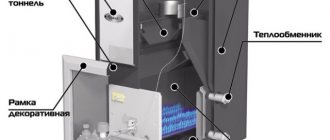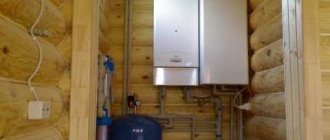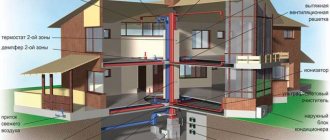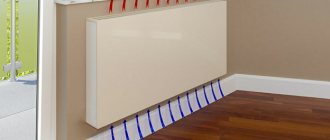Technical development has made it possible to build powerful hydroelectric power stations, learn to use wind energy, and, having comprehended the secrets of the inner layers of the earth, think about creating an alternative method of using accumulated heat in the form of geothermal energy systems.
The fundamental operation of a geothermal heating system is based on the laws of physics discovered by scientists. The search for materials capable of changing their properties while releasing a certain amount of heat has made it possible to create not only conventional refrigeration units and air conditioners, but also powerful heat pumps.
It is with their help that we can transfer the heat that always exists in the bowels of the earth to our home, carrying out coordinated control of the three special circuits that make up the heating system. The purpose of the external circuit is to collect thermal energy from the ground or water. The coolant in it is a non-freezing liquid.
This heat is transferred through the heat exchanger to freon, which fills the second circuit of the system. Its physical properties, consisting in a low boiling point, make it possible to obtain energy during the transition to a gaseous state. Moreover, the temperature coming from the external circuit is quite sufficient for this. The third internal circuit of the heating system represents the required number of radiators and pipes used in the house. It can be separate or common with the hot water supply circuit included in the project.
Working principle of a geothermal pump
Functional features of the system
The operating principle and functional features of a geothermal heating system at home consist of the following steps:
- The solution located in the outer loop acquires additional heating in the ground by about 5 degrees. Its final temperature may be around 3.
- Having entered the heat exchanger of the pump, the solution transfers even its small energy to freon, for which it is quite enough for evaporation. Having passed into a gaseous state, freon enters the compressor, where it is compressed. The thermodynamic processes occurring in this case lead to a rise in temperature to 100. And the hot gas is supplied to the heat exchanger, where it transfers energy to the coolant of the internal circuit, most often water. Thanks to the scientific work of physicists and engineers, this process has been studied in detail and is embedded in the fundamental principles of the operation of various types of modern equipment.
- The coolant of the internal circuit reaches a temperature of 50-70 and enters the radiators and pipes. The cooled freon enters the expansion screen, its temperature and pressure drop to their original values and the entire cycle can be repeated again. The solution of the outer contour moves in the same way into the depths of the earth for a new portion of energy.
Operating principle
Such a phenomenon as geothermal heating, the principle of which is similar to a conventional refrigerator, only in reverse, is becoming increasingly popular. The earth retains heat constantly; objects located on its surface can be heated. The point is that the earth is heated from the inside by hot magma, and from above, thanks to the soil, it does not freeze.
And the operating principle here is as follows: a heat pump is placed on top, and a heat exchanger is lowered into a special earthen shaft. Groundwater flows through the pump and is heated. Thus, the heat generated in this way is used for industrial or domestic purposes. This is how underground heating works.
Schematic diagram of the operation of a heat pump
Note that the main advantage of such a system is that with an electricity consumption of 1 kW, we obtain useful thermal energy in the range from 4 to 6 kW. For comparison, a conventional air conditioner is not capable of converting 1 kW of electricity into 1 kW of thermal energy (the law of conservation of energy, since losses when converting one type of energy into another, alas, has not yet been canceled). Heating using the heat of the earth will pay for itself quickly enough with the right approach to the implementation of geothermal heating.
Designs and types of geothermal heating systems
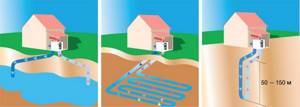
Types of heat pumps
The first issue that has to be resolved in the process of creating a highly economical geothermal heating system is the choice of the type of external circuit, which is a heat exchanger located underground or in water. In this case, it is necessary to take into account not only your desires for the architectural fantasies of a new house, but also detailed geodetic studies of the area in which this house will be located or has already been built.
Not everywhere there are hot springs, geysers, volcanoes, but we are given the opportunity to use the warmth of Mother Earth almost anywhere on the planet. The main thing is to have a clear understanding of the technical side of the matter and the amount of necessary financial investments in any project to create a geothermal heating system.
The most common types of heat exchangers are:
- Horizontal heat exchanger. This option can be considered as an effective proposal only if there is a large free area next to the house. It can only be used as a simple green lawn. Moreover, with a house area of, for example, 220 square meters. m. the heat exchanger will be located on an area of 600 sq.m. The pipes are laid in special trenches, the depth of which should be below the freezing level of the soil in this area.
- Vertical heat exchanger. From a space-saving point of view, this option, of course, has certain advantages. A problem may be the creation of special wells, the depth of which reaches 200 m, with a diameter of about 150 mm. Excavation work with drilling rigs is not cheap in any region. But the soil at such a depth always has a temperature of about 15, which ensures reliable operation of the system with a vertical heat exchanger.
- Heat exchanger at the bottom of the reservoir. The most economical and simplest method for creating the outer loop of a geothermal heating system. Especially if you have your own reliable pond or permission to use a public reservoir. The distance to the reservoir from the house should not exceed 100 m, and its depth should be 3 m.
- There is an option for an open heating system based on the use of water coming from an artesian well. It is passed through a heat pump as a coolant. To reverse the discharge of water, it is necessary to construct a second artesian well. But such a system is not possible in every place. In this case, a very important factor is the return of water in the same amount to the deep layers of the soil to maintain pressure in the layers.
Interestingly, the first attempts to drill wells to harness heat were made in the mid-18th century, but it was not until 1907 that an Icelandic farmer was able to direct hot steam from a nearby source through a cement pipe into his home.
The next step was also taken in Iceland and only in 1903 the first pipeline, 3 km long, appeared in Reykjavik. Currently, geothermal heating systems are very popular in many European countries, the USA, Mexico, Japan, and New Zealand.
Heat exchanger location options
The heat exchanger can be laid out horizontally or vertically. In the first case, the loops are laid at the bottom of the reservoir, in a pit, the installation of the circuit looks like a coil. When installed vertically, the heat exchanger is immersed in shafts or wells.
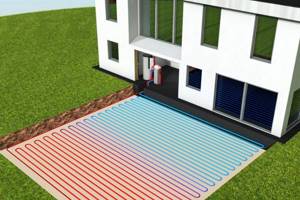
Let's take a closer look at both options:
The most economical and cheap ways to heat a private home
- Vertical construction requires drilling wells to a depth of 200 m or more. At these levels, the soil maintains a temperature of +10 C year-round. If a water-water system is being developed, then two artesian wells are drilled, one of which is used for heat extraction, and the second for water discharge.
- Horizontal placement of the circuit does not require the use of special drilling equipment, but a large area for laying out the loops is required. The pipeline is laid below the freezing point of the soil, for which trenches are dug. In order to determine the area of land for laying out the contour, you need to multiply the area of the house that needs to be heated by 3. It turns out that for a house of 80 m2, the contour is laid out on a plot of 240 m2. Therefore, for horizontal laying it is easiest to use reservoirs, otherwise the entire land adjacent to the house will be occupied.
Important! Horizontal laying of the contour is most often performed at the stage of building a house, during work on cleaning the local area. Vertical installation does not require much space, but you will have to drill wells.
Advantages and disadvantages
Geothermal energy, the reserves of which are so large that only 1% hidden in the earth's crust with a total depth of 10 km can provide a volume 500 times greater than all the world's oil and gas reserves.
There are four main types of geothermal energy:
- This is the heat of the earth from shallow depths, used by heat pumps.
- The energy of hot steam, water in the earth's crust, currently used to produce electricity.
- Heat coming from deep layers without the presence of water and magma energy accumulated in volcanic zones.
- The use of this amazing gift of nature is determined only by the existing level of technology, technological capabilities and economic calculations.
Modern designs of geothermal heating systems have both positive and negative aspects.
The main negative point is the cost. But this only seems at the initial moment. All costs are recouped, according to various data, in 4, 5 years. This is due to the fact that modern heat pump models use much less energy to operate than any other heating system. When consuming 1 kW of electricity, their output is 5 kW.
Positive points:
- They do not burn fuel and do not produce harmful emissions of various compounds into the environment.
- Minimum maintenance costs with high efficiency.
- Environmental Safety.
- Reliable fire safety properties of the system.
Features of using geothermal heating
Ground-level geothermal energy can cause environmental damage to the land and groundwater. The soil may slowly condense, causing it to settle. The resulting holes can release gases that are hazardous to health. In addition, pumping water into rock to release the heat stored in it can lead to strong earthquakes. This was the case in a similar alternative project in Basel (Switzerland) in December 2006, which ultimately led to its closure.
In general, any technology for energy production poses risks. For example, this could lead to accidents at nuclear power plants or dam failures. Therefore, before embarking on energy projects, risks are analyzed and assessed by experts to ensure the safety of people and the environment.
The cost of installation largely depends on the geographical location of the house and the climatic conditions of the region in which you live. After all, the colder it is outside, the deeper the system will have to be installed. Despite the high cost of providing your home with alternative heating, this is a chance to get rid of paying utility bills. It will pay for itself within a few years, and in return you will receive a source of inexhaustible heat that operates autonomously and does not pollute the environment.
Efficiency and payback
Geothermal energy cannot be called a free gift from nature. The creation of heating systems based on it can cost over a million rubles, excluding the cost of a heat pump. It all depends on the required heating volumes, its functional purpose and type. Typically, the economic feasibility of geothermal heating systems is calculated by comparing the costs of its maintenance.
The cost of any type of energy used is not constant and will never decrease. In this regard, their alternative replacement by using the heat of the internal layers is, of course, economically profitable and expedient, since heat pumps do not consume a lot of energy, and to extract and process thermal reserves there is no need to build expensive factories and power plants.
Moreover, each generation of scientists finds new solutions for creating equipment and technologies in this direction. In addition, it is more correct to estimate the cost of heating systems equally for all types of fuel from zero without the use of existing centralized supply systems, for example, gas. And then the payback of the system in 5 years will become a real value.
The use of geothermal heating systems is reminiscent of the question, why not drive a Zaporozhets car nowadays. Of course, you can, especially off-road and into the forest to pick mushrooms. But you want it faster and more comfortably. So it is in this case. The mere thought that your own heating system does not disturb the environment and does not interfere with the lives of even the smallest and most unknown creatures in nature will confirm the correctness of choosing a geothermal system.
Conclusion
Of course, the disadvantages of this type of heating are well compensated by the advantages of geothermal systems. It is worth noting that geothermal heating does not harm the environment. If you are a supporter of “green energy” and are not very limited in budget, then it would be a sin not to use geothermal energy.
Another important advantage of geothermal communications is that they are low maintenance. Just like a good refrigerator, a geothermal pump may not need service for the first 30 years.
Installation and Installation
It is better to install such a heating system not on your own, but by engaging specialists, at least for certain types of work, if you are confident in your own abilities.
The main stages are as follows:
- Calculation of the internal circuit of the heating system. This includes in detail the total length of the pipeline, the number of radiators, the creation of heated floors, and the use of heat to produce hot water in the house.
- Calculation of the laying depth of external circuit pipes for the selected type of heat exchanger. It is necessary to take into account the geodetic data of the area.
- Drilling the required shaft and installing pipes. If there is no centralized water supply at the same time, the easiest way is to solve the issue of creating other water wells. The technology for their creation is different and requires special knowledge.
- Selection and installation of the required heat pump model.
- Installation of automatic devices that monitor the operation of the entire system and regulate the microclimate in any area of the room.
Vertical collectors for heating a house from the ground
These types of collectors are most often used - they are immersed in the ground to a depth of several tens of meters. To do this, the required number of wells are drilled at a short distance from the house, and then pipes (usually made of cross-linked polyethylene) are placed in them. At such a depth, the soil temperature remains high and stable; accordingly, heating a private house with the heat of the earth is highly effective. With this option, collectors do not require a large area.
However, one should take into account a significant drawback of this scheme: heating from the bowels of the earth is expensive. Of course, the initial costs will later pay off, but still not every family can afford such expenses. The cost of drilling is high, and it will take a lot of money to make several wells 50 meters deep.
Pump overview: manufacturers and models
Heat pump device
The efficient functioning of the entire system is determined by the correct choice of heat pump. Based on their operating principles, pumps belong to a modern, environmentally friendly type of equipment. During their operation, no harmful substances are released into the environment.
They are divided into:
- compression;
- absorption heat pumps;
The former are powered by electricity, the latter can use the energy of other types of fuel.
Currently, there are quite a large number of companies on the market for this type of equipment. This allows you to purchase a heat pump for any power through a combination of different models, which is convenient for creating geothermal heating systems on an industrial scale.
The classic option is the use of heat pumps from Waterkotte Germany. This is equipment with a constant efficiency value of up to 500%, independent of external factors. Having started producing heat pumps in 1970, the company constantly updates a large range of modern models without losing high quality.
The new award-winning EcoTouch pump series confirms this fact. It includes models like DC 5027 with output power from 6 to 26 kW and convenient intuitive touch controls. The best modern pumps include the Nibe F1245 model (Sweden), Korsa, Russia. The table shows the estimated cost of individual pump models.
About geothermal heating sources
The following sources of terrestrial thermal energy can be used for geothermal heating:
- high temperature;
- low temperature.
High-temperature ones include, for example, thermal springs. They can be used, but their scope is limited by the actual location of such sources.
While in Iceland this type of energy is actively used, in Russia thermal waters are located far from populated areas. They are concentrated to the maximum in Kamchatka, where underground water is used as a coolant and supplied to hot water systems.
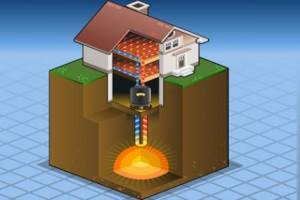
To effectively use the earth's thermal energy, you do not need a volcano. It is enough to use those resources that are located just 200 meters from the earth’s surface
But we have all the necessary prerequisites for the use of low-temperature sources. The surrounding air masses, earth or water are suitable for this purpose.
A heat pump is used to extract the required energy. With its help, the procedure is carried out to convert the ambient temperature into thermal energy not only for heating, but also for hot water supply to a private household.
Image gallery
Photo from
Absorption of free heat from groundwater and rocks
External heat exchanger of the earth-water system
External heat exchanger in a natural reservoir
Geothermal Well Heat Pump
Heat pump cost
| Name | Heating power, maximum value, kW | Heated area, m2 | Price, rubles |
| EcoTouch Ai 1 Geo | from 7.8 to 13.8 | 200-400 | 538 800 – 590 700 |
| EcoTouch DS 5027 AI | from 5.9 to 7.3 | 100-200 | 337 800 – 379 000 |
| F1126 | from 5.56 | 100-200 | from 240,000 |
| F1145 PC | 3,85 | up to 100 | 316 300 – 397 200 |
| HOTJET H-16w | from 5.53 | 200-400 | 291 560 |
Geothermal heating from underground: what is it, how does it work?
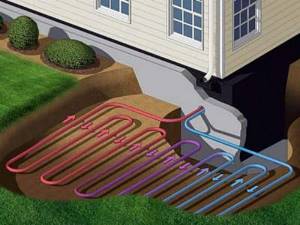
Geothermal heating works like a refrigerator , only for heating. A heat pump is installed on the surface of the earth, from which a heat exchanger is lowered into the shaft.
Groundwater flows upward through the device, heating up along the way. The heated liquid is used to heat rooms.
Energy consumption for heating water is less than the resulting heat transfer.
Principle of operation
The collector supplies warm water to the evaporator. The refrigerant heats up and evaporates. The steam is heated by a compressor using electricity. The condenser cools the steam, causing the release of warm energy and the refrigerant returning to its original liquid state.
Electricity is required to heat water. Each kW spent brings , on average, 5 useful kW of energy.
Equipment list
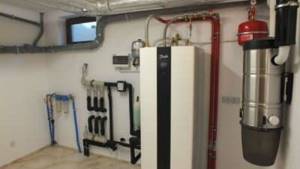
To create a geothermal installation, 4 devices are required:
- collector;
- evaporator with refrigerant;
- compressor;
- capacitor.
Among the listed components, two require an electrical connection: the compressor and the condenser.
Advantages
Geothermal heating has advantages over other types of heating:
- The resulting energy is used for any purpose .
- The duration of fuel supply to a specific area is not limited .
- Its use is environmentally friendly.
- The installation does not require frequent maintenance.
- The system pays for itself over time.
- A geothermal installation takes up little space: no more than a refrigerator.
- If necessary, the system can be easily reconfigured.
- Compatible with other types of heating.
Flaws

Although geothermal heating has many advantages, it also has disadvantages:
- Expensive system and installation.
- Pays for itself in about 10 years.
- The system cannot be used in areas with temperatures falling below 20 degrees.
- Regardless of the type of installation, extensive excavation work using rental equipment.
Review of prices for geothermal heating at home
A full calculation of the creation of a geothermal heating system can only be carried out according to a specific application, taking into account all the requirements. The right thing to do is to choose the nearest company working in this direction and work out all the details under the guidance of specialists. As an example, we can cite the cost of the range of Russian services.
Cost of installation of geothermal heating:
| Heated area of the house (sq. m) | Heat pump power (kW) | Heat pump price (RUB) | The sum of all costs for installing an earthen circuit, including drilling wells and connecting a pump (rub.) | Total: |
| 90-110 | 10,5 | 250 000 | 324 000 | 574 000 |
| 140-150 | 14 | 260 000 | 427 000 | 687 000 |
| 170-190 | 17,5 | 280 000 | 476 000 | 756 000 |
| 200-230 | 21 | 315 000 | 529 000 | 844 000 |
| 330-370 | 35 | 470 000 | 850 000 | 1 320 000 |
Peculiarities
It is worth mentioning several features of geothermal home heating systems.
The difference, for example, from a gas or electric boiler is that it does not require heating the coolant to high temperatures. Low-temperature operation ensures lower energy costs. As is known, in a heating system, an increase in the surface of the radiator is used to compensate for the low temperature of the coolant. To avoid this, it is recommended to use warm floors. In this case, this type of home heating will be more rational, since the heat will flow directly into the living area, and not into the space under the ceiling of the room.
In addition, it is worth recording the minimum heat loss as an asset for heated floors. The amount of heat loss mainly depends on the temperature delta. In the case of low temperature geothermal heating, these losses are minimal. The second significant advantage of underfloor heating is that the house structures themselves (in this case the floor) are directly heated. In the case of radiators, the heated air only slightly covers the glazing of the windows and part of the nearby wall.
Development prospects
Modern industrial technologies used to create new equipment allow almost every owner of his own home to take advantage of the warmth of the deep layers of the earth. The importance of the possibility of reducing energy costs for maintaining a home will only increase over time. Therefore, the process of development and implementation of geothermal heating systems cannot be stopped even by expensive projects. Because, ultimately, this is an undoubted gain and also concern for the environmental heritage of subsequent generations of our planet.
Operating principle of the system
The functioning of geothermal systems is based on the physical processes of heat transfer from the environment. Their operating principle is similar to that of a conventional refrigerator.
At great depths of the earth's surface, the temperature is always constant and ranges from +5 to +8 °C. Almost 80% of the thermal energy produced by a geothermal system is environmental energy. It is transmitted and accumulated inside buildings. Such mining does not damage the ecological and energy balance of the planet, because it has the ability to self-regenerate.
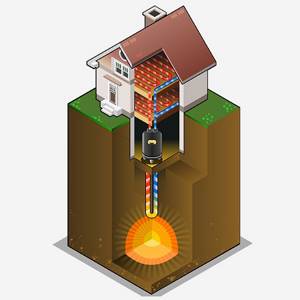
How to make a unit with your own hands?
Regardless of which resource option (earth, water or air) is chosen for heating, a pump will be needed for the system to function correctly.
This device consists of the following elements:
- compressor unit (intermediate element of the complex);
- evaporator , transferring low-potential energy to the coolant;
- throttle valve , through which the refrigerant finds its way back to the evaporator;
- condenser , where freon releases thermal energy and is cooled to its original temperature.
You can purchase a complete system from the manufacturer, but this will cost a decent amount. When there is no free money at hand, it is worth making a heat pump with your own hands from the parts at your disposal and, if necessary, purchasing the missing spare parts.
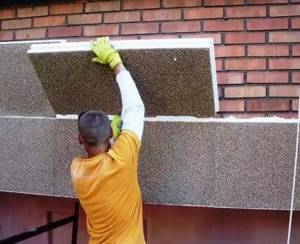
When planning to install a geothermal heating system in a private home, you first need to take care of reducing the level of heat loss. To do this, the walls must be insulated with special material, the doors and window frames must be equipped with foam pads, and the floor and ceiling must be protected with foam panels. Then the maximum amount of heat released by the pump will remain inside the room.
When the decision to make your own heat pump is made, you must definitely check the condition of the electrical wiring and electric meter in the house.
If these elements are worn out and old, it is necessary to inspect all areas, identify possible faults and eliminate them before starting work. Then the system will work flawlessly immediately after startup and will not bother the owners with short circuits, fires in wiring, or knocked out plugs.
Method #1. Assembly from the refrigerator
To assemble the heat pump with your own hands, remove the coil located at the back from the old refrigerator. This part is used as a capacitor and is placed in a highly durable container that is resistant to aggressive temperatures. A properly working compressor is attached to it, and a simple plastic barrel is used as an evaporator.

If a very old refrigerator is used to create a pump, it is better to replace the freon in it with a new one. You won’t be able to do this on your own, so you will have to invite a specialist with special equipment. It will quickly replace the working fluid, and the system will work in the desired mode
The prepared elements are connected to each other, and then the created unit is connected to the heating system through polymer pipes and the operation of the equipment begins.
Step-by-step instructions for assembling a heat pump from a refrigerator are described in this article.
Method #2. Heat pump from air conditioner
In order to make a heat pump, the air conditioner is modified and some main components are redesigned. First, the outdoor and indoor units are swapped.
The evaporator, which is responsible for transferring low-grade heat, is not additionally installed, since it is located in the internal block of the unit, and the condenser transmitting thermal energy is located in the external block. Both air and water are suitable as coolants.
If this installation option is not convenient, the condenser is installed in a separate tank designed for correct heat exchange between the heating resource and the coolant.
The system itself is equipped with a four-way valve. For this work, a specialist with professional skills and experience in conducting events of this kind is usually invited.

Modern split systems are ineffective at low temperatures, so professionals do not recommend using them for making heat pumps yourself
In the third option, the air conditioner is completely disassembled into its component parts, and then a pump is assembled from them according to the traditional generally accepted scheme: evaporator, compressor, condenser. The finished device is connected to the equipment heating the house and started to be used.
The site has a series of articles on making heat pumps with your own hands, we recommend that you read:
- How to make a heat pump for heating a house with your own hands: operating principle and assembly diagrams
- How to make an air-to-water heat pump: device diagrams and self-assembly
Tips for choosing a system
Installation of ground-to-water equipment is more expensive than all other options, because it requires deep excavation when the equipment is located vertically or a large free area when laying communications horizontally.
These parameters limit the use of the system and significantly reduce its attractiveness.
Installing a water-to-water pump also has some limitations. If there is an accessible body of water nearby, you can place the system in it. The lack of open water will entail drilling wells and drainage wells, which is also not cheap.
An air-to-water pump does not pose any installation problems, and can operate correctly even in apartment buildings, but in severe winters with low temperatures, its efficiency decreases and a parallel energy source is required to support it.
However, the installation of geothermal heating eventually pays for its costs and begins to produce a free resource, allowing owners to live in the most convenient, pleasant and comfortable conditions, without spending a lot of money on utilities.
Video description
The operating principle of a heat pump.
Stage two: installation and suitable equipment
Ready-made devices can be used to install geothermal heating. These include the rear coil from the refrigerator, as well as an air conditioner with a modified external and internal circuit. Having decided on the means that plays the role of a circuit, you can start drilling a well.
Its depth should be at least 20-100 meters. A professional drill is useful for this purpose (this is the only manipulation that may require appropriate specialization during installation).
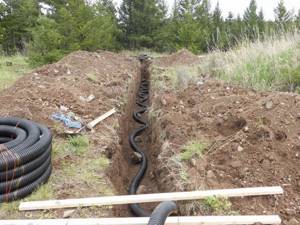
Installation option for a ground collector made of thick pipes Source milligansganderhillfarm.wordpress.com
Also, a pit can be prepared as a place where the external contour will be laid (but only if there is enough free space for this). Sand is poured onto its bottom. Sprinkle enough to completely block the visibility of the soil.
In the prepared trench, the external contour pipes are laid out, forming a spiral or snake. Plastic pipes are also suitable for this purpose, the main thing is that they can withstand pressure up to 6 bar. It turns out that these channels will have to serve as probes. The harness is made up of three or four lines, with the outer sections being formed into U-shaped bends.
Third stage: connecting the heat pump to heating
Connecting a heat pump to heat a house with earth's heat is carried out according to a standard scheme, as in relation to other types of heating systems. For this purpose the following principle is used:
- The contours of the ground collector are brought to the house (to the room where the pump is planned to be installed).
- Next, a buffer tank is connected to the pump, in accordance with the instructions included in the kit, from which the cold circuit is taken out to organize a heated floor and connected through the risers to the heating radiators.
- The heat pump, in turn, outputs two more circuits: cold and warm. They both connect to a boiler or gas water heater.
Similarly, an organized heating system works much more efficiently not only in terms of heat transfer, but also in utility costs.
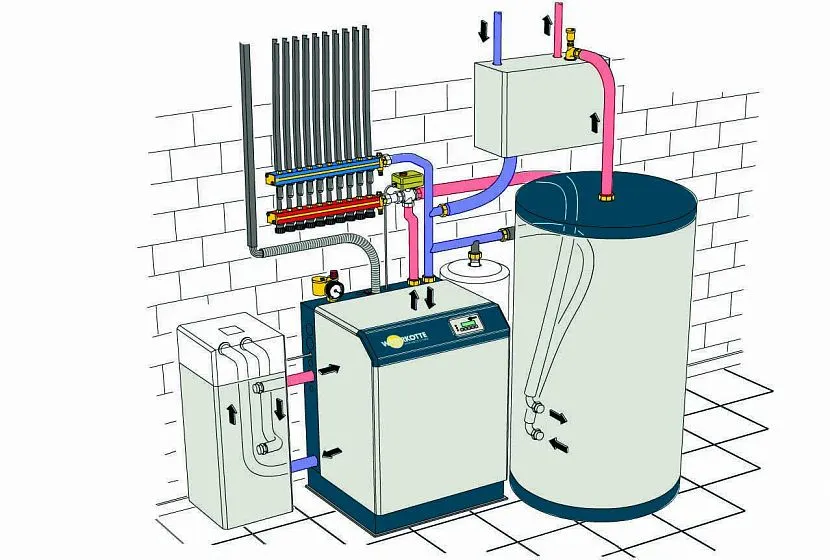
Installation diagram of a heat pump in a geothermal heating system Source eco-kotly.ru
